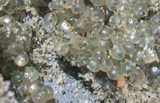Above: Zacherl Lab attending the Western Society of
Naturalists meeting in Monterey, CA in 2005. Top (from L to R): Diana
Lloyd, Sara Koch, Maria Polson, Mike Navarro, Melissa Romero. Bottom (from L to
R): Danielle Zacherl and Amelie, Erin Seale
Welcome to the Zacherl Lab web pages!
The Zacherl lab group's research interests include all aspects of marine ecology
particularly focused on the youngest life stages of marine organisms including settlement and recruitment dynamics, larval behavior, effects of oceanography on larval
distributions and dispersal trajectories, effects of larval dispersal on
population persistence and population connectivity. The Zacherl lab is set up to
support intertidal, subtidal and estuarine research programs. Because of the
collaborative nature of our research, undergraduate and graduate students have
opportunities to interact with faculty and graduate students at UCSB and UCD, as
well as at other institutions. Click on the 'People' links (above left) and read below for more detail about on-going projects.
In our most current research, we are interested in
determining the extent of connectivity among marine populations by tracking
larvae through their dispersal phase. We use calcified
structures such as otoliths, statoliths (see Fig. 1) and shells in marine larvae as natural tags useful for
reconstructing dispersal trajectories. We analyze element incorporation (e.g., Ba, Sr, Mg, Pb, Mn, Zn, Ce)
into these structures using inductively coupled plasma
mass spectrometry (ICP-MS). We have been validating
the use of these structures through culturing experiments that examine which
factors influence element incorporation rates into hard parts.
We are also validating this technique in the field by examining the extent of
temporal and spatial variation in the chemistry of these structures in larvae
developing at different locations. We will continue the validation work and use this natural tag to examine patterns of dispersal in a variety of
marine species.


Figure 1.
Statoliths from larvae and recent recruits of two species of gastropods.
(a) Pair of larval Concholepas concholepas statoliths visible
through fragments of larval shell. (b) Statolith in recently settled
C. concholepas individual. (c) Near-hatch larva of Kelletia
kelletii with statolith visible. (d) Statolith from a near-hatch
larva of K. kelletii with possible daily increments. In (b) the
arrow indicates a potential "hatch" mark measuring 11.40 ± 0.24 microns
(mean ± 1 SE, n = 10) in diameter. In (c) the arrow indicates statolith.
The Zacherl lab group currently examines the ecology and dispersal patterns
of larvae of these species:
1. California Grunion, Leuresthes tenuis.
2. Kellet’s whelk, Kelletia kelletii. Kellet's whelk is a common predatory gastropod
in southern California. In the past few decades, this species extended its range
from its historic northern limit at Point Conception to its present limit in
Monterey Bay. Our demographic studies indicate that the recently established populations north
of Point Conception exhibit very low densities and sometimes exhibit sporadic recruitment pulses. These
features may be due to
limits on northward dispersal of larvae by prevailing current conditions during
K. kelletii's reproductive season. In our continuing work with K. kelletii,
we will examine the relative importance of dispersal in determining patterns in
population structure across the range, and in the relative importance of
linkages among populations in maintaining populations at the edges of the range.
Most recently, we have explored larval diel vertical migration behaviors (DVM)
and are beginning to identify larval distributions in the field. We hope to
investigate the dispersal consequences of DVM using modeling approaches.
3. The Olympia oyster,
Ostrea lurida.
This native oyster species is distributed throughout estuaries along the entire
West Coast of the United states. We are the only group in southern California
currently studying their
recruitment dynamics and population structure. Since their larvae are
brooded for a period of time before entering into the pelagic environment, they
can ‘record’ chemical information about their source estuary in their prodissoconchs and, therefore, represent a good target organism for examining
among-estuary exchange using natural tagging approaches. We are planning an
ambitious study to examine which factors, including larval supply, settlement,
recruitment, growth and mortality, might influence population persistence of the
Olympia oyster within Newport Bay, CA.
We have ongoing and fruitful collaborations with several
fine lab groups because our natural calcified tagging research requires the combined
efforts of many experts. Also, we are in the midst of completing a direct comparison of our
natural calcified tagging approach with genetic approaches for quantifying
exchange of larvae among populations. Past and recent collaborators include Crow White, Steve
Gaines, Bob Warner, Mike Sheehy, Georges Paradis (all at University of
California, Santa Barbara), Steven Morgan (University of California, Davis), Rob
Toonen (University of Hawaii), Stephen Swearer (University of Melbourne) and
Doug Eernisse (California State University Fullerton). Soon, we hope to
join forces with oceanographers and modelers to explore the dispersal
consequences of larval behavior.
Website last updated March 04, 2009